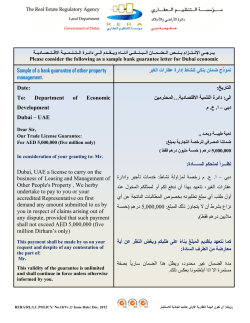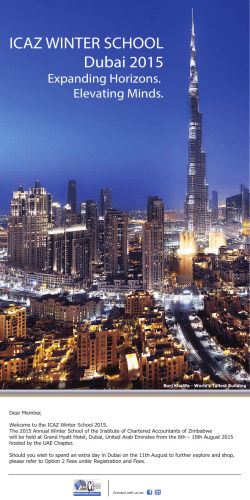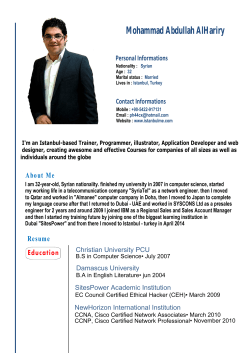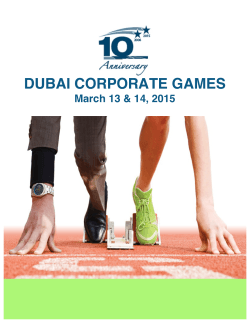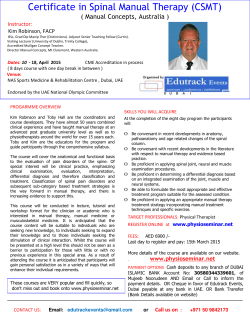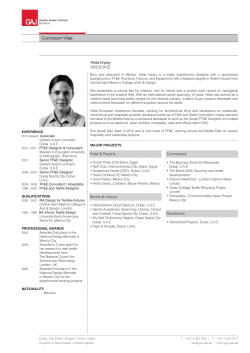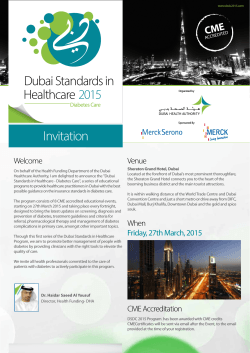
2014 IACSIT LONDON
2015 DUBAI, UAE CONFERENCES May 4-5, 2015 ICRV 2015 2015 International Conference on Robotics and Vision ICSIE 2015 2015 4th International Conference on Software and Information Engineering ICOPR 2015 2015 International Workshop on Pattern Recognition Flora Grand Hotel http://www.florahospitality.com/dubai/deira/dubai-flora-grand-hotel.aspx P.O. Box: 120328, Near Al Rigga Metro Station, Deira, Dubai, U.A.E. Tel: + 971 4 2943660, Mobile: + 971 50 2562275, Fax: + 971 4 2943150 Program 2015 DUBAI CONFERENCES WELCOME LETTER 3 OVERVIEW 4 KEYNOTES 6 DETAILED SCHEDULE 12 SESSION 1: Communications and Information Technology 14 SESSION 2: Computer and Information Sciences 17 CALL FOR PAPERS 21 FEEDBACK 25 2 2015 DUBAI CONFERENCES Dear Participants, Welcome to IACT 2015 Conferences in Dubai! We are confident that over the two days you will get the theoretical grounding, practical knowledge, and personal contacts that will help you build a long-term, profitable and sustainable communication among researchers and practitioners in a wide variety of scientific areas with a common interest in Robotics and Vision topics, software and information engineering topics and Pattern Recognition topics. For the conferences of ICRV 2015, ICSIE 2015, and ICOPR 2015, we had received more than 70 submissions, and around 25 excellent papers were accepted for presentation. Congratulations for these papers. We wish to thank our outstanding keynote speakers Prof. Houssain Kettaniand, Prof. Magne Jørgensen, Prof. Siva Yellampalli, Prof. Christopher Nwosisi, Dr. Carsten Mueller and other distinguished professors for sharing their deep insights on future challenges and trends in Robotics and Vision, software and information engineering and Pattern Recognition topics. Special thanks to all the researchers and students who with their work and participate in the conference. Hope you enjoy the conference, the food, the hospitality, and the beautiful and charming environment of Dubai, UAE! IACT Committee 3 2015 DUBAI CONFERENCES Conference Agenda Overview Monday, May. 4th, 2015 10 :00 am to 5:00 pm Arrival and Registration Lobby Tuesday, May. 5th, 2015 Opening Ceremony 8:45am to 9:00am Prof. Houssain Kettani Fort Hays State University, USA Keynote Address-1: 9:00am to 9:40am Prof. Houssain Kettani Fort Hays State University, USA 9:40am to 10:00am Group Photo & Coffee Break Keynote Address-2: 10:00am to 10:40am Prof. Magne Jørgensen Informatics at University of Oslo, Norway Flora Grand Hall Keynote Address-3: 10:40am to 11:20am Prof. Siva Yellampalli VTU Extension Centre, UTL Technologies Ltd., India Plenary Speech-1: 11:20am to 12:00am 12:00am to 1:00pm Prof. Christopher Nwosisi The College of Westchester & Pace University New York, USA Lunch Monsoon Restaurant Plenary Speech-2: 1:00pm to 1:40pm 1:40pm to 3:25pm 3:25pm to 3:45pm Dr. Carsten Mueller Informatics Department, University of Economics, Czech Republic Flora Grand Hall Session 1: Communications and Information Technology——7 presentations Coffee Break Foyer 4 2015 DUBAI CONFERENCES 3:45pm to 6:30pm 6: 30pm to 8:30pm Session 2: Computer and Information Sciences —— 10 Flora Grand Hall presentations Dinner Monsoon Restaurant Instructions for Oral Presentations Devices Provided by the Conference Organizer: Laptops (with MS-Office & Adobe Reader) Projectors & Screen Laser Sticks Materials Provided by the Presenters: PowerPoint or PDF files Duration of each Presentation (Tentatively): Regular Oral Session: about 15 Minutes of Presentation including 2-3 Minutes of Q&A Plenary Speech: 35 Minutes of Presentation, 5 Minutes of Q&A NOTICE: *Certificate of Participation can be collected in front of the registration counter. *The organizer will not provide accommodation, so we suggest you make an early reservation. *One best presentation will be selected from each session. The best one will be announced when each session ends, and will be awarded by the session chair after each session in the meeting room. *The attendee should provide the author’s authorization or attendee’s passport ID when the attendee is none of the authors. Conference Secretariat Contact: ICRV 2015: Ms. Heleny Yi ([email protected]) ICSIE 2015: Ms. Dorothy Zhang ([email protected] ) ICOPR 2015: Ms. Alice Kuo ([email protected]) Tel: +1-661-888-4278; +86-28-86528298 5 2015 DUBAI CONFERENCES The United States' Challenges in Science and Engineering Education Prof. Houssain Kettani Fort Hays State University, USA Abstract: Numerous statistical data indicate that science and engineering workforce in the United States is aging and nearing retirement. Moreover, various studies show that it has become increasingly difficult to attract American students to science and engineering fields. We present supporting data for different ethnic groups and international students for various degrees in these fields. The situation is particularly grim for Hispanics, who are the fastest growing segment in the population. They remain an untapped in resource, which could either present the solution needed to overcome this challenge, or further deteriorate the situation. The objective of this talk is to shed some light on the situation and suggest some solutions to this predicament that the nation is facing. Biography: Dr. Houssain Kettani was born in 1978 in Khobar, Saudi Arabia. He then moved with his parents in 1981 to Jeddah, Saudi Arabia where he received his K to 6th grade education. He then moved with his parents again to Rabat, Morocco in 1989, where he is originally from and where he received his 7th to 12th grade education. He then moved to Famagusta, North Cyprus in 1995, where he received the Bachelor's degree in Electrical and Electronic Engineering from Eastern Mediterranean University, Famagusta, North Cyprus, in 1998, and moved in the same year to the United States to continue his higher education. In 2000 and 2002 respectively, he received his Master’s and Doctorate degrees both in Electrical Engineering from the University of Wisconsin, Madison, Wisconsin, USA. He served as Assistant Professor of Electrical and Computer Engineering at the University of South Alabama, Mobile, Alabama, USA in 2002-2003, Assistant Professor of Computer Science at Jackson State University, Jackson, Mississippi, USA in 2003-2007, Full Professor of Electrical and Computer Engineering and Computer Science and Director of the Partnership Development Office at Polytechnic University, San Juan, Puerto Rico, USA in 2007-2012, and Professor and Director of Information Systems Engineering at Fort Hays State University, Hays, Kansas, USA since 2012. Dr. Kettani has served as Staff Research Assistant at Los Alamos National Laboratory, Los Alamos, New Mexico, USA in summer of 2000, Visiting Research Professor at Oak Ridge National Laboratory, Oak Ridge, Tennessee, USA 6 2015 DUBAI CONFERENCES in summers of 2005 to 2011, Visiting Research Professor at the Arctic Region Supercomputing Center at the University of Alaska, Fairbanks, Alaska, USA in summer of 2008, and Visiting Professor at the Joint Institute for Computational Sciences at the University of Tennessee, Knoxville, Tennessee, USA in summer of 2010. Dr. Kettani’s research interests include computational science and engineering, high performance computing algorithms, information retrieval, network traffic characterization, number theory, robust control and optimization, and Muslim population studies. He presented his research in over sixty refereed conference and journal publications and his work received over four hundred citations by researchers all over the world. He chaired over hundred international conferences throughout the world and successfully secured external funding in millions of dollars for research and education from US federal agencies such as NSF, DOE, DOD, and NRC. 7 2015 DUBAI CONFERENCES The Use and Misuse of Statistics in Studies on Software Development. Things You Should Know About Statistics That You didn’t Learn in School. Prof. Magne Jørgensen Informatics at University of Oslo, Norway Abstract: The keynote addresses a selection of questionable statistical practices commonly observed in software engineering research. This includes a discussion of the topics: finding pattern in randomness, do you know what p-values means, publication bias, how much can we trust the outcome of statistical tests in software engineering studies?, the consequences of violation of the fixed variables assumption in regression analysis. The topics will be illustrated with observations on how questionable statistical practices have produced misleading and incorrect results in software engineering research. It is important to never use a statistical method without understanding it thoroughly and to never violate statistical assumptions without understanding the likely consequences of doing so. Several changes in statistical practice in software engineering research are suggested. Biography: Magne Jørgensen received the Diplom Ingeneur degree in Wirtschaftswissenschaften from the University of Karlsruhe, Germany, in 1988 and the Dr. Scient. degree in informatics from the University of Oslo, Norway, in 1994. He is a professor of software engineering at the University of Oslo and a member of the software engineering research group at the Simula Research Laboratory. He has 10 years industry experience as a consultant and manager. His research interests include software estimation, uncertainty assessments in software projects, expert judgment processes, and learning from experience. Magne Jørgensen works as a researcher at Simula Research Laboratory and a professor at the University of Oslo. Previously, he worked with software development, estimation, and process improvement in the telecom and insurance industry. He is one of the founders of evidence-based software engineering and teaches this to students and software professionals. His current main research interest is effort estimation, bidding processes, outsourcing, and software development skill assessments. 8 2015 DUBAI CONFERENCES Image Processing for the Next Generation Networks Prof. Siva Yellampalli VTU Extension Centre, UTL Technologies Ltd., India Abstract: The tremendous and continuously accelerated growth in the amount of images and videos distribution over the internet, together with the widespread availability of a wide range of non-PC end-user connected devices (ranging from smartphones and tablets to internet-enabled TV sets), is changing the ways in which people consume visual content. In this environment image processing has to evolve to meet the new requirements such as low bit rate for data storage and transmission, while maintaining acceptable distortion along with minimizing the power consumption. With the increased commercial interest in video communication the need for new international image and video coding techniques are increasing. New video coding techniques and standardization holds the promise of large markets for video communication equipment. In this talk key internet trends along with market growth analysis and new internet trends where image processing is playing a major role are discussed. Then we will briefly look into the history of VLSI implementation of image/video coding techniques such as JPEG, MPEG-1, H.261, MPEG-2, H.263, MPEG-4, and H.264/AVC, and the related coding principles and their effectiveness in the new environment. Participants will gain an understanding of image processing requirements and novel techniques in the next generation video coding standards, along with some perspectives for the future applications and research opportunities. Biography: Dr. Siva Yellampalli is currently working as a Professor with VTU Extension Centre, UTL Technologies Ltd. He obtained his MS & Ph.D from Louisiana State University. His area of research is system level design for power optimization. His area of research encompasses different research fields such as Very Large Scale Integration (VLSI), mixed signal circuits/systems development, micro-electromechanical systems (MEMS), and integrated carbon nanotube based sensors. He has published a book in the area of mixed signal design, and edited two books on carbon nano tubes. He also published multiple International Journal papers & IEEE Conference papers in these areas of research. In addition he has delivered keynote speeches at International conferences held in Canada & Spain including tutorials at various IEEE International Conferences. He has given many professional presentations including invited talks. He has been a consultant to a variety of industries and acts as a reviewer for technical journals and book publishers. Currently he is the Student Activities Chair, Executive Committee IEEE Bangalore Section. He is also a life member of Indian Society for Technical Education (ISTE), senior member, International Association of Computer Science and Information Technology (IACSIT), VLSI Society of India (VSI) and National Society of Collegiate Scholars (NSCS). 9 2015 DUBAI CONFERENCES A Novel Definition of an Efficient Binary Decision Tree Prof. Christopher Nwosisi The College of Westchester & Pace University New York, USA Abstract: Decision trees have been well studied, widely used in knowledge discovery and decision support systems. They are simple and practical prediction models but often suffer from excessive complexity and can even be incomprehensible. In this study, a genetic algorithm is used to construct decision trees of increased accuracy and efficiency compared to those constructed by the conventional ID3 or C4.5 decision tree building algorithms. An improved definition of an efficient binary decision tree is proposed and evaluated – instead of simply using the number of nodes in a tree, the average number of questions asked in the tree for all the database entries is proposed. Biography: DPS, Pace University MS, Polytechnic University BA, Hunter College Certifications: CNA, CNE, Network+, A+, MCSA, CCNA, CCAI Research Interests: Data Mining, Network Architecture, Database Management, Teaching Methodology & Pattern Recognition. "Our classes are comprised of students with diverse work experiences. For those of them with "zero" IT knowledge and those of them who want to change career, our department will give them the hands-on experience that they need. Our small class size encourages team work and one-on-one interaction. Project development is an integral part of our program, and real life projects are used to stimulate and inspire our students." "Tell me and I'll forget; show me and I may remember; involve me and I'll understand." - Chinese Proverb 10 2015 DUBAI CONFERENCES Dynamic Collaboration Structures in an object-oriented IT Governance Dr. Carsten Mueller Informatics Department, University of Economics, Czech Republic Abstract: IT Governance (ITG) is the degree to which the authority for making IT decisions is defined and shared among management, and the processes managers in both IT and business organisations apply in setting IT priorities and the allocation of IT Resources. ITG in a global context has to cater for intensive competition, cultural diversity, and various fluctuating economic conditions. It is viewed as a mixture of various structures, processes, relational mechanisms. The main reason for using object-oriented modelling in the context of ITG is the natural mapping paradigm which allows a one-to-one mapping between objects in the ITG domain being modelled and their abstractions in the object model. Based on this object-oriented ITG model four dynamic and interacting collaboration structures i) Service Component Architecture ii) Service Composition iii) SPSPR Model and iv) Team- and Target Formation are implemented. The dynamic collaboration structures are supported by design patterns/principles (e.g. watchdog), clustering, recommender and metaheuristics for optimization. The relationships and collaborations in ITG and BITA are configured using a query language, analysed and optimized – at runtime. This component-based software architecture with minimum coupling and maximum cohesion provides a flexible ITG platform for the main activities direct, align, monitor and analyse. Based on (business-) requirements/optimizations it is possible to substitute and extend existing components on demand and at runtime. This leads to well-adapted ITG and improves a) information flow,b) workflow, c) management-/decision support d) resource allocation and e) value creation from the IT investment in the context of ITG including Business-IT Alignment (BITA). This plenary speech provides a general overview about this intelligent and fascinating solution. The practical demonstration is focussing on Change Management (COBIT, BAI06) and BITA. Biography: Carsten Mueller holds a M.Sc. degree from the University of Liechtenstein in Vaduz and a Ph.D. degree from the University of Economics (Department Informatics and Statistics) in Prague. He works over 15years as an independent consultant and trainer in the areas of IT process optimization, object-oriented modelling and IT governance. He is currently the technical head of processes and IT management at a large airport in Germany and a senior lecturer for software engineering, UML and algorithms at the Baden-Wuerttemberg Cooperative State University. 11 2015 DUBAI CONFERENCES Detailed Schedule Monday, May 4th Location Lobby 10:00 – 12:00 13:00 — 17:00 Arrival and Registration Tips: After sign, you will collect your conference package, including: Original Receipt Journal (Only for Author Attendee) Representative / Pass Card with Tie Printed Program Lunch Coupon Dinner Coupon *Certificate (collected from Session Chair after the presentation) Conference Souvenir Computer Bag Notice: Please check on all these materials as soon as you get the package; if any of them is not included in the package, please let us know at once; If any of them gets lost after the registration, no additional one would be provided. Your understanding will be appreciated! Each regular registration covers only one package. Additional package will be charged. Some attendees may arrive on May 5, kindly be noted that you can register at the registration desk from 9 am onwards. 12 2015 DUBAI CONFERENCES Tuesday Morning, May 5th Opening Ceremony Location Flora Grand Hall Opening Ceremony 8:45am to 9:00am Prof. Houssain Kettaniand Fort Hays State University, USA 9:00am to 09:40am Keynote Address -1: The United States' Challenges in Science and Engineering Education Prof. Houssain Kettaniand Fort Hays State University, USA 9:40am to 10:00am 10:00am to 10:40 am Group Photo & Coffee Break Keynote Address-2: The Use and Misuse of Statistics in Studies on Software Development. Things You Should Know About Statistics That You didn’t Learn in School. Prof. Magne Jørgensen Informatics at University of Oslo, Norway 10:40am to 11:20 am Keynote Address-3: Image Processing for the Next Generation Networks Prof. Siva Yellampalli VTU Extension Centre, UTL Technologies Ltd., India 11:20 am to 12:00am Plenary Speech-1: A Novel Definition of an Efficient Binary Decision Tree Prof. Christopher Nwosisi The College of Westchester & Pace University New York, USA 13 2015 DUBAI CONFERENCES 12:00am——1:00pm Lunch Time Location Monsoon Restaurant Tips: Please be noted that lunch coupon is necessary for entering the Monsoon Restaurant. Please arrive on time to the Flora Grand Hall by 12:55 pm. Thank you! Tuesday Afternoon, May 5th Plenary Speech-2: 1:00 pm to 1:40am Dr. Carsten Mueller Informatics Department, University of Economics, Czech Republic -PAPER SESSIONSSession 1: Communications and Information Technology Chair: Prof. Christopher Nwosisi 7 presentations Time: 1:40pm to 3:25pm Venue: Flora Grand Hall A Novel Definition of an Efficient Binary Decision Tree Christopher Nwosisi College of the City University of New York, US E3003 Abstract — Decision trees have been well studied, widely used in knowledge discovery and decision support systems. They are simple and practical prediction models but often suffer from excessive complexity and can even be incomprehensible. In this study, a genetic algorithm is used to construct decision trees of increased accuracy and efficiency compared to those constructed by the conventional ID3 or C4.5 decision tree building algorithms. An improved definition of an efficient binary decision tree is proposed and evaluated – instead of simply using the number of nodes in a tree, the average number of questions asked in the tree for all the database entries is proposed. 14 2015 DUBAI CONFERENCES On a New Competence Measure Applied to the Combining Multiclassifier System Marek Kurzynski Wroclaw University of Technology, Poland Abstract — In this paper a new method for calculating competence of a classifier in the feature space is presented. The idea of method is based on relating the response of the classifier with the decision profile of a test object which is evaluated using K nearest R010 objects from the validation set. The measure of competence reflects this relation and rates the classifier with respect to the similarity nting the dynamic classifier selection (DCS) and dynamic ensemble selection (DES) strategies are developed using proposed measure of competence. The performance of proposed MCS’s was compared against seven multiple classification systems using six benchmark datasets taken from the UCI Machine Learning Repository and Ludmila Kuncheva Collection. The experimental investigations clearly show the effectiveness of the combining multiclassifier system in dynamic fashion using proposed measure of competence regardless of the ensemble type used (homogeneous or heterogeneous). Performance Enhancement in 5G Mobile Network Processing Eba' Almousa and Feda Alshahwan Public Authority for Applied Education and Training, Kuwait E006 Abstract — Networks are developing to increase the data speed and channels bandwidth. Many attempts have been carried out to achieve the main demands of faster connectivity and download. This study presents most of the attempts and researches to deploy 5G. However, the new 5G network technology is still in its infancy stage and lacks standardization. Component-Based Model for Heterogeneous Nodes in Wireless Sensor Networks Atif Naseer, Basem Alkazemi and Hossam Aldoobi Umm al Qura University, Saudi Arabia Abstract — Data exchange between heterogeneous motes in a network requires careful understanding of the data model adopted by E012 every mote type. This can be a very challenging concern, especially when dealing with a wide variety of motes at runtime where new nodes can join a network to provide certain services. This paper identifies the key architectural characteristics of two commonly recognized operating systems, namely TinyOS and Contiki, which behave differently when dealing with data exchange and state control. The aim is to map the architecture of TinyOS and Contiki on to a component-based software engineering model. This discussion leads to describing abstractly the design of a generic component-based middleware model to address interoperability issues when dealing with these two types of motes. Integral Architecture For Organizational Systems -ARQUETIPOSAna Milena Paez Quintero, Ricardo Llamosa Villalba and Edgar Sneyder Garcí a Morantes CIDLIS-UIS, Colombia E019 Abstract — ARQUETIPOS is a meta-model that combines structural elements given by TOGAF, Enterprise Architecture, agile methods and ZACHMAN frameworks, with prototyping and simulation techniques. There are advantages to this model such as its iterative approach, which grants real-time results to stakeholders. Also, when using this model, requirements and solutions evolve through the collaboration of high performance teams. From an ontological approach ARQUETIPOS is composed of five components: The Framework for Capability, the Content of the Architecture, the Implementation Method, the Maturity Assessment Model of Organizational Systems and the Meta-model Repository. This paper aims to test the implementation of ARQUETIPOS in 15 2015 DUBAI CONFERENCES the education and productive sector through the use of agile principles and prototyping and simulation techniques. The techniques or strategies used to implement this meta-model are varied, in this case the training service was used. This strategy allowed the main actors in this paper (Academia and companies) to model their organizational processes through the creation of prototypes with Lego. In consequence, that let them to get better services and products aligned with their business strategy. Location based and contextual services using Bluetooth Beacons: New way to Enhance Customer Experience Nilima Dudhane and Sanjeevkumar Pitambare TechMahindra Ltd., India Abstract — Location based services and context facilitates innovative ways to enhance customers “in-location” experience. Indoor spaces often block cell signals and make it difficult to track customer’s indoor activities via existing technologies like GPS, RFID E0023 and Cellular tower triangulation etc. These limitations can be addressed using Bluetooth Beacons. Using beacons, retailers can optimize customer experiences, improve business processes and generate more revenue. Retailers and telecommunication service providers can do the partnerships with each other to enhance in-store shopping experience of customer and provide personalize offers. In this paper, authors have proposed, how Bluetooth beacons can be beneficial to retailers in terms of customer analytics, operational analytics and revenue improvement along with partnering with service providers to enhance customer experience and loyalty. Developing Abuse Cases Based on Threat Modeling and Attack Patterns Xiaohong Yuan North Carolina A & T State University, US Abstract — Developing abuse cases help software engineers to think from the perspective of attackers, and therefore allow them to E024 decide and document how the software should react to illegitimate use. This paper describes a method for developing abuse cases based on threat modeling and attack patterns. First potential threats are analyzed by following Microsoft’s threat modeling process. Based on the identified threats, initial abuse cases are generated. Attack pattern library is searched and attack patterns relevant to the abuse cases are retrieved. The information retrieved from the attack patterns are used to extend the initial abuse cases and suggest mitigation method. Such a method has the potential to assist software engineers without high expertise in computer security to develop meaningful and useful abuse cases, and therefore reduce the security vulnerabilities in the software systems they develop. Tuesday Afternoon, May 5th 3:25pm to 3:45pm Location Foyer -PAPER SESSIONS- 16 2015 DUBAI CONFERENCES Session 2: Computer and Information Sciences Chair: Dr. Carsten Mueller and Asst. Prof. Alaa Halawani 10 presentations Time: 3:45pm to 6:30pm Venue: Flora Grand Hall A Supervised Learning Approach for the Fusion of Multiple Classifier Outputs Cagdas Ulas, Bilge Koroglu, Can Bekar, Okan Burcak and Onur Agin Yapi Kredi Bank/R&D and Special Projects Department, Kocaeli, Turkey Abstract — In this paper, we propose an alternative method for the fusion of multiple classifier outputs to obtain a potential R006 idual classifiers, which are trained on different data sets, share common classes and some of them also individually deal with classifying different class labels. For this reason, we first aim to define a common space to represent all the class labels and then propose a supervised learning approach to effectively recognize patterns of the tuples that are formed by concatenating classifiers outputs based on top-N rankings. To evaluate the performance of our method, we utilize Random Forest (RF) classifier for this multiclass classification problem and the results demonstrate that our method can achieve promising performance improvement in true positive rate of classification compared to that of the best performing individual classifier yields. Image Quality Improvement in Kidney Stone Detection on Computed Tomography Images Saman Ebrahimi and Vladimir Mariano Institute of Computer Science, University of the Philippines Los Baños, Philippines Abstract — Kidney-urine-belly computed tomography (KUB CT) analysis is an imaging modality that has the potential to enhance R009 kidney stone screening and diagnosis. This study explored the development of a semi-automated program that used image processing techniques and geometry principles to define the boundary, and segmentation of the kidney area, and to enhance kidney stone detection. It marked detected kidney stones and provided an output that identifies the size and location of the kidney based on pixel count. The program was tested on standard KUB CT scan slides from 39 patients at Imam Reza Hospital in Iran who were divided into two groups based on the presence and absence of kidney stones in their hospi-tal records. Of these, the program generated six in-consistent results which were attributed to the poor quality of the original CT scans. Results showed that the program has 84.61 per cent accuracy, which sug-gests the program’s potential in diagnostic efficiency for kidney stone detection. Human Ear Localization: A Template-based Approach Alaa Halawani and Haibo Li Department of Applied Physics and Electronics (TFE), UmeåUniversity, Umeå, Sweden R012 Abstract — We propose a simple and yet effective technique for shape-based ear localization. The idea is based on using a predefined binary ear template that is matched to ear contours in a given edge image. To cope with changes in ear shapes and sizes, the template is allowed to deform. Deformation is achieved by dividing the template into segments. The dynamic programming search algorithm is used to accomplish the matching process, achieving very robust localization results in various cluttered and RV1000 Parallel Computed Tomography Technique Akram Boukhamla, Hayet Farida Merouani, and Hocine Sissaoui Badji Mokhtar University-Annaba, Algeria 17 2015 DUBAI CONFERENCES Abstract — Since the Filtered Back-projection algorithm (FBP) requires significantly long computational time when the amount of data becomes increasingly large; which is the case of Computed Tomography (CT), parallel computing technique is used in MatLab, as it enables the implementation of multi-tasking. Exploiting this advantage by partitioning the input data and allowing each core of cluster to work on its own sub-image (2, 4, 8, 16). Therefore, Filtered Back-projection algorithm was applied simultaneously on all cores. All the reconstructed sub-images will be sent to the Client in order to be gathered. The comparison results between a sequential FBP algorithm and the parallel algorithm, show that the parallel computing process is up to seven times more efficient than the sequential algorithm on the voluminous images size, otherwise the small images results were poor because of the workers intercommunications that require times comparing with the sequential algorithm that takes a short computational time. Team formation based on nature-inspired swarm intelligence Carsten Mueller and Christian Eichmann, Germany University of Economics, Faculty of Informatics and Statistics, PragueBaden Wuerttemberg Cooperative State University Mosbach E009 Abstract — This paper describes an application to form teams from a given set of employees. The teams are assigned to perform task. To accomplish a task a team has to fulfill specific requirements which have to been minded while assigning teams to task. The goal is the forming of a chain of task meeting specific requirements and assigning a team to each task able to solve it. These chains have to be optimized for a synergy value representing how well employees work together. There is one synergy value for each possible pair of employees. Plugin for Visual Paradigm for generating and intelligent optimization of a Component Diagram based on attributes in the Class Diagram Carsten Mueller and Anton Pohl University of Economics, Faculty of Informatics and Statistics, PragueBaden Wuerttemberg Cooperative State University Mosbach, Germany E010 Abstract — In today’s software development process (SDP) it is necessary to do much preparatory work to achieve a good quality of the software. Besides the requirements engineering the design process is very important. The designer can describe all aspects of the software to be built. Excellent designing skills and the question “What makes a ‘good’ software?” are essential to create a competent “cookbook”. The plugin presented in this paper shall support designer using Visual Paradigm (VP) as a modeling-tool during their modeling process. Based on given attributes in the Class Diagram the plugin can generate and optimize intelligently a Component Diagram. Recognition of Modern Arabic Poems Abdulrahman Almuhareb, Waleed Almutairi, Haya Altuwaijri, Abdulelah Almubarak and Marwa Khan King Abdulaziz City for Science and Technology (KACST), Saudi Arabia E0020 Abstract — We propose a machine learning method for recognizing modern Arabic poems based on the common poetic features of modern Arabic poetry. The poetic features include: rhyming, repetition, use of diacritics and punctuations, and text alignment. The method can classify text documents as poem or non-poem documents with a very high accuracy of 99.81%. Application and Assessment of Classification Techniques on Programmers’ Performance in Software Industry Sangita Gupta and Suma V. Jain University, Bangalore E3001 Abstract — Software companies seek to develop and maintain high quality products along with increasing reliability and maintainability. Therefore, companies look into every aspect for project success. Software companies try to improve efficiency in process by using different techniques. With best hardware, operating system and methodologies, still there have been disastrous 18 2015 DUBAI CONFERENCES software failures. It is found that most software failures are due to lack of focus on people working on the process. Human aspect of software engineering has thus become an emerging stream and it is identified as core factor for project success. Therefore, human aspect needs deep investigation in this ever changing field of software development. One of the strategies is to process and analyze previous data of software companies to predict future failures. Data mining techniques have the ability to uncover hidden patterns in large databases. Software companies can build models that predict with a high degree of accuracy the attributes required in human aspect for success. Through these predictive data mining models, companies can effectively address issues ranging from selection, retention to development and effectively manage the team members. The purpose of this paper is to use different data mining algorithms on project personnel data and compare the accuracy of these algorithms. Kinematics Modeling of a 4-DOF Robotic Arm Amin A. Mohammed and M. Sunar King Fahd University of Petroleum & Minerals, Saudi Arabia Abstract — This work presents the kinematics model of an RA-02 (a 4 DOF) robotic arm. The direct kinematic problem is RV0008 addressed using both the Denavit-Hartenberg (DH) convention and the product of exponential formula, which is based on the screw theory. By comparing the results of both approaches, it turns out that they provide identical solutions for the manipulator kinematics. Furthermore, an algebraic solution of the inverse kinematics problem based on trigonometric formulas is also provided. Finally, simulation results for the kinematics model using the Matlab program based on the DH convention are presented. Since the two approaches are identical, the product of exponential formula is supposed to produce same simulation results on the robotic arm studied. A Proposed Model for Code Quality Maturity Model Fariha Motherudin and Noor Ezleen Moksen MIMOS Bhd, Malaysia Abstract — The information technology (IT) industry is characterized by rapid innovation and intense competition. A key issue is the ability of the development team to leverage emerging software development best practices. It is a critical enabler for the overall health and sustainability of an organization's ability to build software solutions. In this paper, we are proposing an evolutionary E004 model that could be a reference for others in the area of utilizing best practices in the area of code and build management. The best practices studied in this paper are included static code analysis, automated unit testing, continuous integration, release gate checking and technical debt. The proposed model is expected to help appraising the maturity level of the produced codes, build and release management practices. It aims to satisfy the characteristics defined at five levels and estimate the target level that one try to achieve. The proposed model is based on several years of real world experience with a big number of teams from the software engineering field. The classification level is based on practices that practitioners observed during the software development life cycle. The processes have evolved from an independent process using an independent tool to prediction process using technical debt ideas which hope this proposed model would be beneficial not only to the software engineers but also to the organization as a whole 19 2015 DUBAI CONFERENCES Tips: The best paper will be chosen after each session and the certificate will be awarded by the chair. Good Luck! Tuesday Evening, May 5th 6:30 pm to 8:30 pm--Dinner Location Monsoon Restaurant Tips: The Dinner will start at 6:30pm. Please kindly attend on time with bringing the Dinner Coupon. 20 2015 DUBAI CONFERENCES 21 2015 DUBAI CONFERENCES 22 2015 DUBAI CONFERENCES 23 2015 DUBAI CONFERENCES 24 2015 DUBAI CONFERENCES Please take a few moments to provide us some important feedback about your professional development of Dubai conferences. ------------------------------------------------------------------------------------------------------------------------- Conference Feedback Use the key below Very Good□ Good□ Poor□ Use the ranking key above as appropriate to answer the questions below on the blank spaces provided at the end of each questions How was the overall organization of the conference How do you rate the registration area How do you rate the presenter(s) Did you gain any helpful skills How was the format of the meeting in terms of lunch, coffee breaks? Overall, how were the conference facilities How was the reception you received at the conference How was the venue List other locations where you think future meeting should be held Why did you choose that venue? Generally, how was the whole experience at the meeting, and given another chance would you attend or recommend next year's conference? Comments and Suggestions 25
© Copyright 2025
